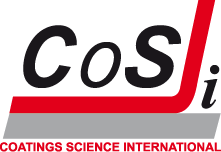Speakers COSI 2006
- Ingo Alig, Deutsches Kunststoff-Institute, Germany, Monitoring of film formation, cure and ageing of coatings by an ultrasonic reflection method
- Dante Battocchi, Department of Coatings & Polymeric Materials and Department of Chemistry, USA, The use of multiple electrochemical techniques to characterize Mg-rich primers for Al alloys
- Gordon Bierwagen, North Dakota State University, USA, Lifetime prediction for corrosion protective coatings from electrochemical measurements - a new perspective
- Francesco Ciardelli, University of Pisa, Italy, Conferring dichroic properties and optical responsiveness to polyolefins through organic chromophores and metal nanoparticles
- Jacques Devaux, Université Catholique de Louvain, Belgium, Polymer-based nanocomposites: overview, applications and perspectives.
- Kurt Dietliker, Ciba Specialty Chemicals Inc, Switzerland, Advancement in photoinitiators - opening up new applications for radiation curing
- Bart Erich, Eindhoven University of Technology, The Netherlands, Drying of alkyd coatings on porous substrates measured with high resolution MRI
- Alexander Fedorov, University of Groningen, The Netherlands, Degradation and recovery of adhesion properties of deformed metal-polymer interfaces studied by laser induced delamination
- Maurizio Fermeglia, University of Trieste, Trieste, Italy, Multiscale modeling for polymer systems of industrial interest
- Santiago Garcia, Universitat Jaume I, Spain, Anticorrosive evaluation of organic powder coatings by means of electrochemical techniques (EIS and AC/DC/AC)
- Alex van Herk, Eindhoven University of Technology, The NetherlandsFrom emulsion polymerization to nanotechnology
- Jos Huybrechts,DuPont Performance Coatings, Belgium, 2.1 VOC solvent borne 2K clear coats based on star oligoethers
- Christine Jérôme University of Liège, Belgium, New developments in electrografting of thin polymer films
- Sonny Jonsson, Fusion Systems, USA, Free radical induced photopolymerization of thio-ether vinyl esters
- Bart Noordover, Eindhoven University of Technology, The Netherlands, Renewable polyester resins for powder coating applications
- Ger Koper, Delft University of Technology, The Netherlands, UV-protective coatings: what to learn from nature
- Yoshinori Kushi, Nippon Paint Co, Japan, Molecular design of novel grafting polymer for aqueous pigment dispersants
- Sviatlana Lamaka, University of Aveiro, Portugal, TiOx nanostructured sublayer as reservoir of corrosion inhibitors for pre-treatments with self-healing ability
- Daniel Maetens, Cytec Surface Specialties, Belgium, Weathering degradation mechanism in polyester powder coatings
- Marshall Ming, Eindhoven University of Technology, The Netherlands, Surface wettability control inspired by nature
- Tijs Nabuurs, DSM NeoResins, The Netherlands, Nanomorphology control in aqueous coatings
- Louise Nobel, Delft University of Technology, The Netherlands, Waterborne nanocomposite coating
- Willem Posthumus, Stahl International, The Netherlands, Reactions of carbodiimides with free and bonded carboxylic acids
- Paula Puomi, University of Cincinnati, USA, Novel, one-step, chromate-free coatings containing anticorrosion pigments for metals
- Alexander Routh, University of Sheffield, UK, Surfactant distributions in latex films
- Hiroshi Sasaki, , Toagosei Co, Japan, High performance cationically curable formulations
- Carsten Schellenberg, Ciba Specialty Chemicals Inc., Switzerland, Polymer colloids by miniemulsion polymerization - new additives for waterborne coatings -
- Wolfgang Schrof, BASF Aktiengesellschaft, Germany, Combinatorial materials research of UV coating formulations
- Mohamad Shalati, Nuplex Resins LLC, USA, Controlled molecular structure polymers
- Masamitsu Shirai, Osaka Prefecture University, Japan, Reworkable UV curing materials
- Petra Uhlmann, Leibniz Institute of Polymer Research Dresden, Germany, Research agenda surface technology: Future demand of research in the field of coatings materials
- Leo van der Ven, Akzo-Nobel Coatings, The Netherlands, Interactions between basecoats and clearcoats in car refinish systems
- Douglas Wicks, The University of Southern Mississippi, USA, Impact of waterborne dispersants on bioide efficacy
- Harm Wiese, BASF, Germany, Nanocomposite dispersions - An innovation in waterbased coatings
- Frederik de Wit, Netherlands Institute for Metals Research (NIMR), The Netherlands, Bonding of organic molecules on aluminium and magnesium alloys
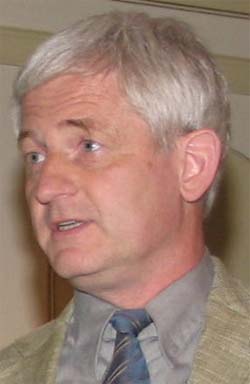
Dr. Ingo Alig
Deutsches Kunststoff-Institut, Darmstadt, Germany
Title Lecture
Monitoring of film formation, cure and ageing of coatings by an ultrasonic reflection method
Authors
I. Alig, D. Lellinger, S. Tadjbach and H. Oehler
Abstract
During film formation, cure and/or ageing of coatings changes in physical properties and chemistry of the material occurs. For this processes one have to consider a complex interplay of different factors. In order to get a more detailed insight in the mechanisms of film formation, cure or aging, it is desired to be able to monitor the changes of the mechanical properties in real time. In this work different modifications of an ultrasonic reflection technique [1] enabling such an analysis are described [2-5]. The ultrasonic method measures the complex acoustic reflection coefficient (changes in amplitude and phase) between a substrate and the coating for transversal and/or shear waves at ultrasonic frequencies. From the complex acoustic reflection coefficient and the density of the sample the corresponding mechanical moduli and Poisson’s ratio can be calculated [3]. Different ultrasonic setups have been developed for monitoring of film formation from aqueous dispersions and solvent-based coatings [2,3], for curing of epoxies [3] or acrylates (including UV-curing [4]) and simulated weathering. The method can be considered as a real time dynamic mechanical analysis at high frequencies. Physical changes like vitrification, swelling and drying, crack initiation or delamination can be well monitored by this method. Recently, the ultrasonic reflection technique has been combined with near-infrared analysis [5] for monitoring of UV curing. Moreover, the method was used to detect material changes while the samples are exposed to simulated weathering. Furthermore, setups for high throughput experimentation have been developed.
References:
- W.P. Mason, W.O. Baker, H.J. McSkimin, J.H. Heiss, Phys.Rev., 1949, 75, p. 936-946.
- I. Alig, D. Lellinger, J. Sulimma, S. Tadjbakhsch, Rev. Sci. Instr., 1997, 68, p. 1536.
- D.Lellinger, S. Tadjbach, I. Alig, Macromol. Symp. 2002, 184, p. 203–213.
- I. Alig, D. Lellinger, H. Oehler, Adhäsion, 2005, 49 (5),p. 36-39.
- P.A.M. Steeman, A. A. Dias, D. Wiencke, I. Alig, D. Lellinger, Progress Organic Coatings, 2005 (in press).
Curriculum vitae:
- Ingo Alig (Ph.D., D.Sc.)
- Head of Department of Physics at Deutsches Kunststoff-Institut in Darmstadt, Germany lecturer at Technical University Darmstadt
Education
- Ph.D. 1983 in Physics, Technical University Merseburg
- Habilitation (D.Sc.)1988 in Experimental Physics
Positions
- 1978-1991 Senior scientist at Department of Physics at Technical University Merseburg 1989-91 visiting scientist at Research Center of Crete/Greece, McMasters University Hamilton/Canada, Max Planck Institute for Polymer Science
- 1991-1993 senior scientist at the Institute for Physical Chemistry of University Köln 1993-now Head of department of Physics at the Deutsche Kunststoff-Institut and lecturer at Technical University Darmstadt
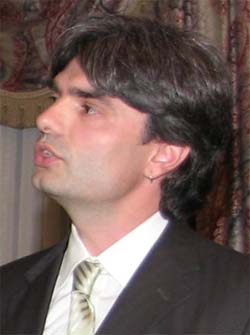
Dante Battocchi
North Dakota State University, Department of Coatings & Polymeric Materials and Department of Chemistry, Fargo, ND USA
Title Lecture
The use of multiple electrochemical techniques to characterize Mg-rich primers for Al alloys
Authors
Gordon Bierwagen, Dante Battocchi, Aldo Simoes, Anthony Stamness and Dennis Tallman
Abstract
To insure that the
corrosion protective behavior of Mg-rich primers over Al aircraft alloys
is properly understood, multiple electrochemical techniques have been
utilized to characterize the behavior of this class of Cr-free coatings.
The electrochemical testing was done in conjunction with the subjective
“qualification” testing of the primer materials for US Air Force and
Navy specifications so that as this new class of primers did not
encounter any unexpected corrosion protection-related deficiencies. To
confirm that the Mg-rich primer did indeed provide cathodic, sacrificial
protection to these alloys, the mixed corrosion potential of the mixed
Al-Mg system the Open Circuit Potential (OCP),can be used to show when the potential
of the alloy substrate is modified by contact with the Mg to yield a
potential cathodic to the Al Alloy
This was done by a steady state measurement of the total system OCP in
immersion and also by the measuring the potential of the minimum/free
corrosion current (icorr) in a potentiodynamic scan of the mixed
system. Both methods yielded values in excellent agreement, but initial
studies with a system top-coated with a high quality topcoat gave
problems in OCP measurement due to an exceedingly high impedance causing
steady-state measurement difficulties. Electrochemical Impedance
Spectroscopy (EIS) and Electrochemical Noise Methods (ENM) were also
used to characterize the system in immersion. Further, the Scanning
Vibrating Electrode Technique (SVET) was used to examine local damage
protection by the Mg-rich primer about a deliberately induced scratch in
the coatings system. These results for the Mg-rich primer system yield a
very interesting self-consistent set of data showing cathodic protection
of one reactive metal (Al) by another more reactive metal (Mg).
Biography
Dante Battocchi,earned a degree of Doctor in Materials Engineering at Trento University (trento, Italy) and Master degree in Coating Science at NDSU (Fargo, USA). Currently he is a Research Associate in the department of Coatings and Polymeric Materials in the North Dakota State University, Fargo (USA).He is leading the development of the Mg-rich primer, a totally chrome free system conducting electrochemical studies on other types of coatings supervising and training students.
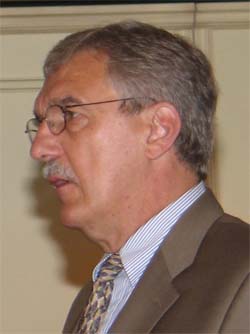
Prof.dr. Gordon Bierwagen
North Dakota State University, Department of Coatings and Polymerix Materials, Fargo, ND, USA
Title Lecture
Lifetime prediction for corrosion protective coatings form electrochemical measurements - A new perspective
Authors
G.P. Bierwagen, B.R. Hinderliter, S.G. Croll, D.E. Tallmann and Q. Su
Abstract
Electrochemical resistance measurements on
the accelerated weathering of corrosion protective coatings systems in
this laboratory have yielded time series data that can be fit by a
simple exponential decay function in time. A description of how this can
be empirically used for lifetime prediction for coatings has already
been presented[1][2][3][4]
In this paper we will present a simple model that can be used to
interpret these results. This simple model which considers only loss of
coating thickness by UV-induced ablation is applied to the
interpretation of EIS time series results from coatings systems
undergoing accelerated weathering. Next, more complete models which
description of electrolyte transport in coating films are applied to the
same problem. Incorporating these models for degradation as a simple RC
equivalent circuit representation of a coating gives predictions of EIS
performance that have reasonable agreement with experimental data.
Using a two layer representation of coating together with the
application of known effective medium theories for dielectric and
resistivity changes due to water intrusion allow prediction of the
changes in EIS spectra seen in accelerated testing of coating films.
These results illustrate the power of modeling physical processes in
interpreting electrochemical data from coating films and predicting
coating protective lifetimes
- G. Bierwagen, J. Li, Lingyun He, and D. Tallman “Fundamentals of the Measurement of Corrosion Protection and the Prediction of Its Lifetime in Coatings”, Chapter 14 in Proceedings of the 2nd International Symposium on Service Life Prediction Methodology and Metrologies, Monterey, CA, Nov. 14-17, 1999, ACS Symposium Series # 805, J. Martin and D Bauer, ed., ACS Books, Washing ton, DC (2001) 316-350
- C. Schiller & W. Strunz, “The evaluation of experimental dielectric data of barrier coatings by means of different models,” Electrochimica Acta, 46 2001 3619-25
- S. Duval, M. Keddam, M. Sfaira, A. Srhiri, H. Takenouti, “Electrochemical impedance spectroscopy of epoxy-vinyl coating in aqueous medium analyzed by dipolar relaxation of polymer,” J. Electrochem. Soc., 149 (2002) B520-9
- J.M. Hu, J.Q. Zhang, C.N. Cao, ”Determination of water uptake and diffusion of Cl- ion in epoxy primer on aluminum alloys in NaCl solution by electrochemical impedance spectroscopy,” Prog. Organic Coatings 46 (2003) 273-279
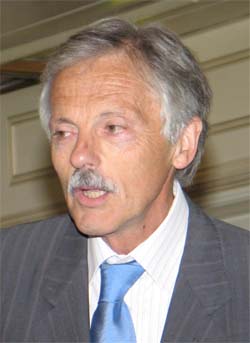
Francesco Ciardelli
Dept.Chemistry and Industrial Chemistry,University of Pisa and PolyLab-INFM,Pisa,Italy
Title Lecture
Conferring Dichroic Properties and Optical Responsiveness to Polyolefins Through Organic Chromophores and Metal Nanoparticles
Authors
Andrea Pucci,Giacomo Ruggeri,Simona Bronco,Monica Bertoldo,Chiara Cappelli,Francesco Ciardelli
Abstract
Organic Chromophores nanoaggegates and Gold nanoparticles coated with chromophoric thiols can be dispersed into polyolefins functionalized with polar groups to various extent either by casting from solvents or by melt mixing. Also polymer/gold nanocomposites are prepared by photoreduction of gold chlorides in the presence of hydroxyl containing ethylene copolymers .The characterization of the morphology of the resulting composites containing less than 3% w of optical additive shows the presence of nanodispersed particles .The resulting thin films can be oriented by mechanical stretching of the polymer thus providing films with high absorption and emission dichroism, the dichroic ratio being higher than 30 and than suitable for commercially used linear polarizers . The optical response can be modulated to high extent by varying the degree of dispersion and the amount and dimensions of the dispersed phase by modulation of the interface nature. In particular by selecting appropriate stilbene containing chromophores thin polyolefin films were obtained showing optical response in the visible to mechanical stimuli.Also a combination of the experimental data and quantum mechanical investigations allowed to correlate the optical response to the molecular structure complexity of the chromophores and to the molecular and sovramolecular organization in the polymer matrix.
- N. Tirelli, S. Amabile, C. Cellai, A. Pucci, L. Regoli, G. Ruggeri, F. Ciardelli" New terthiophene derivatives for ultrahigh molecular weight polyethylene-based absorption polarizers"Macromolecules, 34, 2129 (2001)
- A. Pucci, N. Tirelli, G. Ruggeri, F. Ciardelli "Absorption and emission dichroism of polyethylene films with molecularly dispersed push-pull terthiophenes,Macromol. Chem. Phys., 206, 102-111 (2005)
- F. Ciardelli, A. Pucci, G. Ruggeri, V. Liuzzo"Conferring smart behaviour to polyolefins through compatible blending with organic dyes and metal derivatives"ACS Symposium Series,916,18( 2005)
Biography
Professional career
- Doctor degree 1960 University of Pisa
- PhD 1968 Rome
- Research Associate, University of Pisa 1960-1965, University College, London 1965;
- Postdoctoral Fellow, Max Planck Institute, Mülheim/Ruhr (FRG) 1966-67;
- Assistant Professor, University of Pisa, 1968-1975;
- Visiting Professor, University of California, Berkeley (USA) 1973 and 1985; Kyoto University (JAPAN) 1983; Polytechnic
- Zurich (ETH) 1986;
- University P.M.Curie, Paris (France) 1999.
- Professor of Polymer Chemistry, University of Pisa, since 1975.
Professional activity
- Member of the Scientific Board of three CNR Centers
- Member of the Scientific Board,CNRS Lab.,Lyon(France) (1986-1989)
- Chairman of the Italian Macromolecular Association (AIM) (1983-85)
- Chairman of 10 (eight) International Conferences
- Full Member of IUPAC-MACROMOLECULAR Division (1986-88)
- Invited Speaker to: three Gordon Research Conferences, 25 IUPAC Symposia, and more than 80 International Meetings
- Member of the European Polymer Federation Steering Committee (1988-1996)
- Director of the Departement of Chemistry and Industrial Chemistry of the University of Pisa (1996-1999)
- Chairman of the Division of Industrial Chemistry of the SCI (1997-2000)
Membership of Journals Advisory Boards
- Polymer Int., since 1983
- J. Polymer Science, 1983-1989
- New Polymeric Materials, 1989-99
- Polymers, since 1989
- Polymers for Advanced Technologies, since 1990
- J. Molecular Catalysis, 1995-2003
- Macromolecular Chemistry & Physics, since 1996-2002
- Polymer Bulletin, since 2004
Research Interests
- Transition Metal Catalysts for Olefin Polymerization
- Stereochemistry and Chirality in Macromolecules
- Clean Industrial Processes
- Polymer Functionalization ,Reactive Blending and Composites
- Photoresponsive and Electroconducting Polymeric Materials
- Polymers for Coatings and Packaging
Publications
320 papers in refereed journals, 250 presentations to scientific meetings, 11 patents, 8 books.
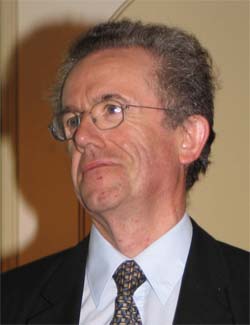
Dr. Jacques Devaux
Université Catholique de Louvain, Département des Sciences des Matériaux et des Procédés, Unité de Chimie et de Physique des Hauts Polyméres, Louvain-La-Neuve, Belgium
Title Lecture
Polymer-based nanocomposites: overview, applications and perspectives
Authors
J.J.D.G. Devaux
Abstract
Nowadays
"Composite" is an usual name given to a material to which (at least) two
solid constituents provide not only average but "higher than additive" (
so-called "synergistic" ) properties. In the most usual acception such
properties are mechanical, but they could be of electric, optic, even
biologic nature."Nanocomposite"
means a composite into which the filler exhibits (at least) one
dimension in the "nanometer" (10-9 m ) scale.
In this case the prefix nano- was not added (only) for fashion, or because the
nanometer became an "observable" dimension in the late 1980's, but
decreasing the dimension(s) of the filler down to such a small scale
allows to enhance the contribution of the contact zone (the so-called
"interface zone" or, more precisely the "interphase") to the overall
properties of the (nano-)composite. This "interphase" is the volume of
the matrix what is "modified" by the presence of the neighbour solid
filler.
For instance, for a spherical glass-like filler, going from I micron
down to I nanometer diameter increases the contact surface from about
2,5 to 2500 m2/g. If the interphase is only I micron thick, in the
latter case, less than 0.1% by weight of such a "nano"filler is enough
to "modify" all the material !
Among nanocomposites which appears by now close to wide range
applications, polymer-clay nanocomposites attracted most of the efforts.
Owing to the growing interest for polymer-clay nanocomposites, the
amount of research in this field exploded from the first Toyota's team
report in 1990.
Applications are now looked for in the automotive industry where
lightweigth, gloss, fire resistance are a few of the desirable
properties for a material. But outside this most popular domain,
medical, as well as food, coatings, etc. applications are arising.
So far, the price of
the final materials, partly linked to the cost of the wet treatment
needed for the pristine clay, remains a major factor hindering the
commercial development of nanocomposites. But perspectives exist by now
allowing the direct use of untreated cheap clay as starting material.
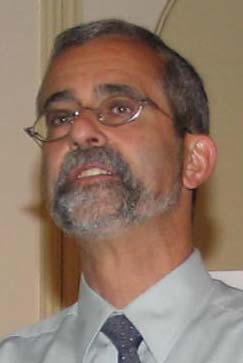
Kurt Dietliker
Ciba Specialty Chemicals Inc., Basel, Switzerland
Title Lecture
Advancements in Photoinitiators – opening up new Applications for Radiation Curing
Abstract
Over the past decades,
radiation curing has found widespread use in an increasing number of
industrial applications. Photoinitiators are key components in all
photopolymerizable formulations, which allow the efficient
transformation of the energy of light into chemical energy in the form
of initiating species. A variety of efficient photoinitiators for
different applications is today commercially available and used in
coatings, printing inks or electronic materials.
However, several
challenges for radiation curing still remain. These include for example
the curing of thick or highly pigmented coatings or of coatings applied
on three dimensional objects. Odor and extractables in the cured
coatings are another issue of concern. Newly emerging applications
eventually create novel requirements for the curing process and the
properties of the cured material.
Further improvements
of photoinitiators and the development of new compounds are therefore
essential for the further expansion of the UV curing technology. Modern
photoinitiators are in fact more than just catalysts for the
polymerization process: they are an integral part of sophisticated
formulations, providing excellent properties in the manufacturing
process and during the service time of the cured article.
This will be
illustrated by some recent developments in photoinitiators.
Well-approved
initiator classes for radical photopolymerization have been
significantly improved and optimized for use in coatings for outdoor
applications and in printing inks. The new compounds allow fast cure and
provide excellent properties to the cured coating, including no
yellowing after cure and upon long-term weathering and low odor and
extractables in printing inks.
A new type of photoinitiator has recently been introduced for use in color filter
fabrication. The compound can meet the challenging requirements
regarding light transmission in the resist material, thereby
guaranteeing the purity of the color in the display.
The development of
photolatent amines, a completely new class of photoinitiators, has
eventually made new resin types accessible for radiation curing. Either
conventional coating formulations or newly designed formulations can be
used with these photoinitiators. The alternative base catalyzed curing
mechanism allows to overcome some of the limits of radically curing
formulations. Coatings of excellent performance are obtained, and the
scope of radiation curing is considerably expanded by this new
technology.
Biography
Kurt Dietliker studied
organic chemistry at the University of Zurich and received his PhD for a
thesis on the photochemistry of aminoazirine and isoxazole heterocyles.
After a postdoctoral year at the University of Fribourg focusing on the
elucidation of the di-p-methane rearrangement, he joined the research
department of the Additives Division of the former Ciba-Geigy AG in
Marly.
After a short time
dedicated to other topics, he became involved in photoinitiator
research. Over the years, his work focused on the development of several
new photoinitiators for radical and cationic curing. In addition to
numerous patents and scientific papers in this field, he is the author
or co-author of three books on photoinitiators.
Currently he holds the
position of a Senior Research Fellow and is responsible for the
development of new photolatent acids and bases for the Coating Effect
Segment of Ciba Specialty Chemicals Inc. in Basel.
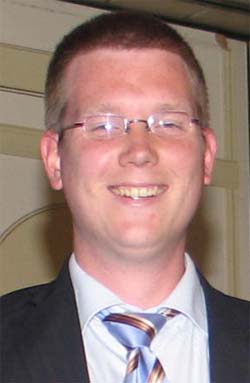
Bart Erich
Eindhoven University of Technology, Department of Physics, The Netherlands
Title Lecture
Drying of alkyd coatings on porous substrates measured with high resolution MRI
Authors
S.J.F. Erich, O. Adan, H.P. Huinink, L. Pel, K. Kopinga
Abstract
Many coatings are applied on porous substrates, e.g., wood, stone, or gypsum layers. The porosity of the substrate largely influences the drying behavior of the coating. Three phases can be distinguished. First, the solvent and/or the resins penetrate the substrate. In the second stage, the solvent evaporates from the coating and substrate. In the third stage, the coating starts to solidify by the formation of cross-links (curing). The depth of penetration is one of the important variables that determine the adhesive properties of the final fully cured coating. For the different types of alkyd coating (solvent borne, high-solid, and waterborne) applied on wood it is known that the penetration depth varies. The penetration can be altered by changing the viscosity of the coating. Monitoring the penetration and its effect on the drying of the coating as a function of depth is of major importance for the development and improvement of products. Until recently, no techniques were available to follow this process in-depth as a function of time with a high resolution (about 5 µm). In our studies, we found that with high resolution MRI the penetration of the substrate (wood and gypsum) can be observed. Not only the penetration depth and the evaporation process can be monitored, but also the chemical curing inside the substrate. We monitored the drying of a commercial available solvent borne alkyd coating. The results showed that the coating completely penetrated the wooden substrate and started curing inside the wood. We also investigated a waterborne alkyd emulsion on a gypsum substrate. Direct after application of this waterborne alkyd emulsion, the water is absorbed into the gypsum. Our data indicate that curing not only takes place at the surface of the coating, but also on the coating/substrate interface. The results clearly demonstrate the added value of high resolution MRI for research on the interaction of a coating with its substrate.
Biography
Ir. Erich received his master degree in physics at the Eindhoven University of Technology in 2002, in the group Transport in Permeable Media. During his study he designed and built a low field 3D Magnetic Resonance Imaging (MRI) setup for different kinds of drying experiment in permeable media. Afterwards he continued his work in this group as a Ph.D. student. His research is focused on the drying behavior of coating systems, in particular alkyd coatings. To study the physical and chemical processes in these coatings he constructed a specialized high resolution NMR setup.
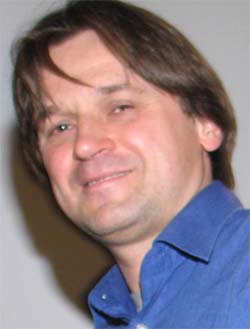
Alexander Fedorov
Department of Applied Physics, Materials Science Centre and the Netherlands Institute for Metals Research, University of Groningen, Groningen, The Netherlands
Title Lecture
Degradation and recovery of adhesion properties of deformed metal-polymer interfaces studied by laser induced delamination
Authors
A.Fedorov, R. van Tijum, W.-P. Vellinga, J. Th. M. De Hosson
Abstract
Adhesion properties of polymer coatings on metals are of great interest
in various industrial applications, including packaging of food and
drinks. Particular interest is focused on metal-polymer interfaces that
are subjected to significant deformations during manufacturing process.
In this work beverage cans are examined which are manufactured by deep
drawing processes from polyethylene terephthalate pre-coated steel
sheets.
The experimental technique used in this study is a laser induced
delamination method. In this technique a coating is subjected to a
series of infrared laser pulses with a stepwise increase of intensity.
Upon increasing the laser pulse intensity, the pressure which is formed
inside the blisters reaches a critical value, resulting in further
delamination of the coating. From the experimental results the critical
stresses required for the delamination and the practical work of
adhesion are derived. The processing of the experimental data is based
on a linear elastic description supported by finite element modeling.
The measurements have demonstrated a strong correlation between the
adhesion strength of the metal-polymer interface and the strain
introduced by the deformation. After applying a thermal treatment
restoration of the adhesion properties has been observed. The thermal
treatment parameters (temperature, duration) were varied in order to
optimize the effect of recovery.
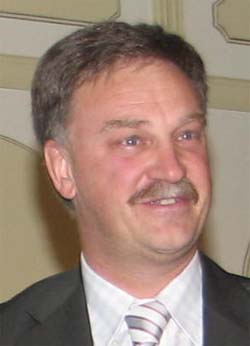
Maurizio Fermeglia
Molecular Simulation Engineering Laboratory, Department of Chemical Engineering, University of Trieste, Piazzale Europa 1, 34127 Trieste, Italy
Title Lecture
Multiscale modeling for polymer systems of industrial interest
Authors
Maurizio Fermeglia and Sabrina Pricl
Abstract
Atomistic –based simulations such as molecular mechanics (MM), molecular
dynamics (MD), and Monte Carlo-based methods (MC) have come into wide
use for materials design.
Using these atomistic simulation tools, we can analyze molecular
structure on the scale of 0.1-10 nm. However, difficulty arises
concerning limitations of the time- and length-scale involved in the
simulation. Although a possible molecular structure can be simulated by
the atom-based simulations, its is less realistic to predict the
mesoscopic structure defined on the scale of 100-1000 nm, for example
the morphology of polymer blends and composites, which often dominates
actual material properties. For the morphology on these scales,
mesoscopic simulations such as the dynamic mean field density functional
theory (Mesodyn) and dissipative particle dynamics (DPD) are available
as alternatives to atomistic simulations. It is therefore inevitable to
adopt a mesoscopic simulation technique and bridge the gap between
atomistic and mesoscopic simulations for an effective material design.
Furthermore, it is possible to transfer the simulated mesoscopic
structure to finite elements modeling tools (FEM) for calculating
macroscopic properties for the systems of interest.
In this paper, we present a hierarchical procedure for bridging the gap
between atomistic and macroscopic (FEM) modeling passing through
mesoscopic simulations. In particular, we will discuss the concept of
multiscale (or many scale) modeling, and present examples of
applications of multiscale procedures for polymer-organoclay
nanocomposites for the estimation of the binding energy and basal
spacing of a montmorillonite – polymer – surface modifier system.
Examples of application of multiscale modeling to immiscible polymer
blends and polymer – carbon nanotubes systems will also be presented.
Biography
Maurizio Fermeglia was born in Trieste,
October 9th 1955. Maurizio Fermeglia graduated in Chemical Engineering
at the Engineering Faculty of the University of Trieste in 1980. He got
his habilitation for chemical engineer in 1985. In 1981 and 82 he worked
as visiting scientist at the Denmark Technical University (DTH). His
current position is full professor at the Engineering Faculty of the
University of Trieste, where he holds the course in ‘Chemical Reaction
Engineering’, ‘Process Simulation’ and ‘Data base’. He is member of the
PHD Council of the University of Padova and Trieste. He has been
involved in teaching for the following courses: Physics, Physical
Chemistry, Computer calculation, Unit operations, Transport and
thermodynamic properties measurements, Transfer processes and units,
Object Oriented Programming, Net Economy at University of Trieste.
He has been teaching courses and seminars
for industries and academia on the following topics: phase equilibrium
and thermodynamics, equilibrium properties calculation, process
simulation, applied thermodynamics, molecular simulation, multiscale
modeling for polymers. He held seminars on Programming, Operating
Systems, Data Base, Networking, Internetworking, multimedia.
The main research activities are focused
on transport and thermodynamic properties, their experimental
determination, correlation and prediction, chemical process analysis and
synthesis and molecular modeling. In computer science his main research
activity is in the Data Base and Internet – Intranet. He is scientific
consultant of ICS - UNIDO within the Subprogram 'Process Simulation'
from 1999. He is IUPC fellows from 2003. He is reviewer of the following
journals: AIChE Journal, Industrial Engineering Chemistry, Fluid Phase
Equilibria, J. Chem. Eng. Data, Chemical Engineering Science, J.
Supercritical Fluids, Polymers and Polymer Composites, Fuel Cells,
Industrial and Engineering Chemistry, Chemical Engineering and
Processing.
He is author of more than 200 publications
in national and international journals and conference proceedings on
thermodynamics, molecular modeling, process simulation and computer
science.
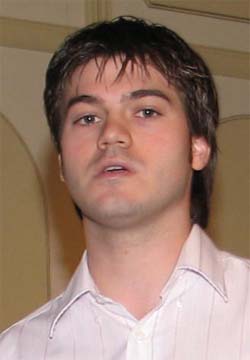
Santiago Juan Garcia
Área de Ciencia de los Materiales, Departament d’Enginyeria de Sistemes Industrials i Disseny, Universitat Jaume I, Avda. Vicent Sos Baynat s/n, 12071 Castellón, Spain.
Title Lecture
Anticorrosive evaluation of organic powder coatings by means of electrochemical techniques (EIS and AC/DC/AC)
Authors
S.J. Garcíaa,*, A. Serrab, J.J. Suayc
Abstract
In the field of the organic coatings, one of the most actual researching
interests is to develop a new technique able to evaluate the primers in
very short times. The actual evaluation methods, like salt fog spray,
are very subjective and acquire long times of exposure, being difficult
to give a quick idea of the anticorrosive properties. Various
electrochemical techniques have been used to evaluate the performance of
organic coating/metal systems. The application of electrochemical
impedance spectroscopy (EIS) to coated metals has been proved to be a
useful technique in the study of the corrosion performance of
anticorrosive primers [1, 2], although it takes days, weeks and
sometimes months to obtain good results. During last years a rapid
method for testing coated metals consisting in a combination of DC and
AC measurements (AC/DC/AC procedure) has been developed [3-5] in our
group.
EIS and AC/DC/AC techniques have been used in this work in order to
evaluate the anticorrosive properties of different organic powder
coatings, showing good accordance between the two techniques and with
the salt fog spray, traditionally used in the industry. The different
techniques have been applied to a traditional epoxy powder coating
system (bisphenol-A cured with o-tolyl-biguanide) and to different new
low curing temperature epoxy powder coatings using
trifluromethanesulfonates of Erbium and Ytterbium (III) as catalysts. A
full characterization of the different systems has also been carried out
showing that catalysts improve the curing meaningfully, lowering the
curing time for a given temperature and conversion degree and at the
same time showing good mechanical and anticorrosive performance.
- Bierwagen G.P., J. Coat. Tech., 64 (1992) 71-75
- Hernández L.S., del Amo B., Romagnoli R., Anti-Corrosion Methods and Materials, 46 (1999) 198-204
- Hollaender J., Schiller C.A., Strunz W., Proceedings of the EIS 2001, Marilleva (Italy), (2001)
- Rodríguez, M.T., Gracenea, J.J., García, S.J., Saura, J.J. and Suay, J.J., Prog. Org. Coat., 50 (2004) 123-131
- Rodríguez, M.T., García, S.J., Gracenea, J.J., Cabello, R., Suay, J.J., J. Coat. Tech., 2 (7) (2005) 557-564
Keywords: epoxy resin, catalyst, AC/DC/AC, EIS, triflate.
Biography
Santiago Garcia studied chemistry at the Jaume I University at Castello, Spain. He graduated in 2001. Afterwards
het joined the Valencia Polytechnic Univeristy in Valencia, Spain were
he currently is working on his PhD thesis.
Fields of Interest:
- Thermosetting materials
- Polymer characterization (mechanical, thermal…)
- Anticorrosive properties of organic coatings
- Curing kinetics
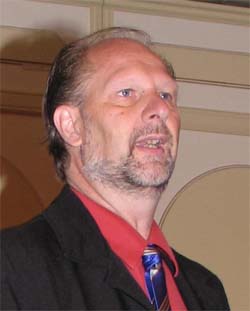
Prof. dr. Alex van Herk
Eindhoven University of Technology, laboratory of polymer chemistry.
Title Lecture
From emulsion polymerization to nanotechnology
Authors
prof. Alex M. van Herk
Abstract
The Eindhoven group on emulsion polymerization has contributed to the
field of encapsulation of many types of particles like pigments, fillers
and clay particles, preparation of hollow multicompartment particles,
encapsulation of nanotubes with latex particles and to the control of
molecular microstructure and morphology through on-line techniques like
Raman spectroscopy. Added to this is the introduction of controlled
radical polymerization techniques as an additional means to control
molecular microstructure and morphology in latex systems.
All these developments are very relevant for the next generation of
coatings in which, more than in the past, improved properties are
related to nanostructuring of the components in the coatings.
In this presentation an
overview will be given on the many ways nanotechnology can be performed
in the field of emulsion polymerization.
Biography
Alex van Herk is full professor in polymer chemistry in Eindhoven and visiting professor at the University of Göttingen (Germany). He graduated from the Free University of Amsterdam on the kinetics of ligand substitution reactions in vitamin B12 and joined the Eindhoven University of Technology in 1986 where he is active in the area of emulsion polymerization, polymerization kinetics, nanocomposites and alternative sources of initiation in polymerization processes. He is a member of the IUPAC working party on modelling of polymerization kinetics and a member of the international polymer colloids group. Since june 2001 he is director of the educational program in the faculty of chemical engineering and chemistry in Eindhoven. Furthermore he is chairman of the industrial liaison program emulsion polymerization.
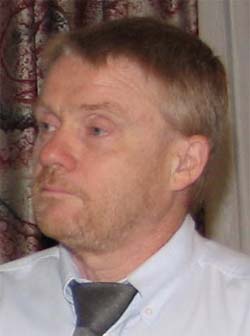
Jos Huybrechts
DuPont Performance Coatings, Mechelen – Belgium
Title Lecture
2.1 VOC solvent borne 2K clear coats based on star oligoethers
Authors
Jos Huybrechts, Leen Tanghe
Abstract
The new European legislation for 2K car repair topcoats and clear coats
forces the customers to use 3.5 VOC products by 2007. As of 2007, new
VOC limits will be discussed depending on the state of the technology.
The next step may be 2.1 VOC and this limit can only be obtained with
solvent borne products having a solids content of minimum 75%. It was
believed that such high solids content could only be obtained with
oligomers in which the reactive functional groups are blocked in order
to get a sufficient long potlife. The crosslinking with the
polyisocyanates can only take place when there is sufficient air
humidity, water present in order to hydrolyze the oligomers during the
film formation stage and become reactive with the isocyanates. Such
systems will always lack robustness of application.
In this paper we will discuss a new class of hydroxyl functional star
polyethers that allow formulating regular 2K clear and top coats at 2.1
VOC with an acceptable overall balance of potlife, appearance and drying
properties.
Biography
Jos Huybrechts finalized his PhD from the
University of Leuven in 1978 - Department Macromolecular and Organic
chemistry with specialization in photochemistry and photophysics.
In 1978 he started with Dupont de Nemours Mechelen Belgium in R@D
Fluoroproducts.
In 1980 he moved to R@D resin development for OEM,Car repair,Trade and
Industrial paints as well as specialty adhesives. (Dupont Fabrics and
Finishes)
End 80 ties he got additional assignment for several years in resin
development for UV cure ( Dupont Electronics) and bead resins. (Dupont
Specialty resins)
Since 1992 he is focusing only on resin development for OEM and Car
repair. (Now Dupont Performance Coatings)
He is holding 40-50 patents mostly in the field of resins for OEM and
Car repair and have several publications in this area of expertise.
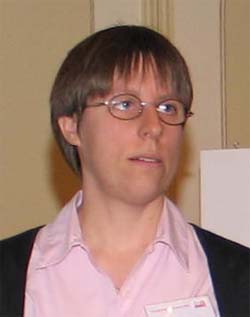
Dr. Christine Jérôme
Center for Education and Research on Macromolecules (CERM)
University of Liège, B6 Sart-Tilman, B 4000 Liège, Belgium
Title Lecture
New developments in electrografting of thin polymer films
Authors
C. Jérôme, S. Gabriel, M. Cécius, R. Jérôme
Abstract
Electrografting is a one-step technique for tethering polymer chains
onto conductive surfaces. In this process, polymerization of (meth)acrylic
monomers is initiated at a well-controlled cathodic potential, whereas
the chain propagation results from the chemical addition of the monomer
to activated grafted species independently of the potential. This
process has been successfully applied to a variety of acrylic monomers
with the purpose to modify extensively the surfaces properties.
In a first example, an acrylate bearing a polymerization initiator in the
ester group, thus an inimer, has been electrografted. Then
polymerization of a second monomer (vinyl aromatic, lactone, cycloolefin…)
has been initiated from the electrografted film ("grafting from"
process), which allows for the film thickness to be increased in a
controlled manner, for block copolymers to be synthesized and for
nanostructures to be formed on the surface.
In a second example, N-succinimidyl acrylate has been electrografted,
followed by the chemical grafting of a variety of nucleophiles, e.g.,
proteins, aminopolymers, aminoferrocene, by reaction with the
succinimidyl substituents of the chemisorbed polyacrylate chains.
Finally, the electrografting of macromonomers, e.g., end-functional
poly(ethylene glycol), poly(dimethylsiloxane) and poly(vinyl methyl
ether) has been carried out. Surfaces with very specific properties such
as protein repellency, high hydrophobicity and temperature responsivity,
have accordingly been made available.Developments in the field of
biosensors will be emphasized.
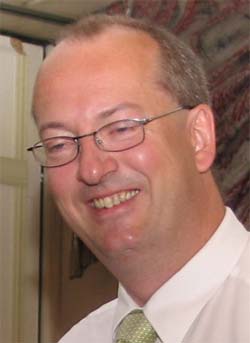
Sonny Jonsson*
Fusion UV-Curing Systems, Gaithersburg, MD 20878, USA
Title Lecture
Free radical induced photopolymerization of thio-ether vinyl esters
Authors
E. Sonny Jönsson Tai Y. Lee, Todd M Roper, C A. Guymon and C E. Hoyle
- Fusion UV-Curing Systems, Gaithersburg, MD 20878
- University of Southern Mississippi, Department of Polymer Science, Hattiesburg, MS 39406:
- University of Iowa, Department of Chemical and Biochemical Engineering, Iowa City, IA 52242-2527
Abstract
The photopolymerization of vinyl acrylate/multifunctional thiol (trimethylol
propane tris (3-mercaptopropionate)) mixtures as a function of thiol
content in the presence and absence of photoinitiators has been
investigated using real-time FTIR, thin-film calorimetry, and 2D-COSY
NMR. The addition of a multifunctional thiol to vinyl acrylate
significantly enhances the conversion of the vinyl double bonds of vinyl
acrylate due to the preferential addition of the thiyl radical to the
vinyl group. It was observed that two separate free-radical
polymerization processes, acrylate homopolymerization and thiol/vinyl
ester copolymerization, occur simultaneously in thiol/vinyl acrylate
mixtures. Thin-film calorimetry and 2D-COSY NMR results are consistent
with real-time FTIR results and give strong evidence for two separate
free-radical processes.
One particularly interesting aspect of photopolymerization deals
photoinitiator free photocuring processes by using monomers that
self-initiate free-radical polymerization upon irradiation. In
photoinitiator-free systems, various deleterious effects inherent to
traditional photocuring including low initiation efficiency, residual
extractable photoinitiator species, yellowing, and degradation resulting
from unwanted byproducts can be eliminated. Recently, Hult et al.[4]
reported photopolymerization results for a difunctional monomer with a
reactive maleimide grou and an acrylate. Interestingly, since maleimides
have been used as photoinitiators, [5-7] the difunctional maleimide/acrylate
reported by Hult et al. [4] polymerized when exposed to light in the
absence of an added photoinitiator. In this case, the maleimide not only
initiates, but also participated in the free-radical polymerization
process Another difunctional monomer with two reactive groups (acrylate
and vinylester) that can participate in free-radical polymerization is
vinyl acrylate.
Research on vinyl acrylate polymerization was
reported by Fukuda et al in the early 1970s. [8-9] This research focused
primarily on polymerization behavior of the two different functional
groups and cyclic polymerization in solution. Recently, Kudyakov et al.
[10-11] reported real-time infrared (RTIR) results showing that in bulk,
the acrylate group homopolymerizes to about 70 percent conversion before
the vinyl ester group begins to react. It was reported that the vinyl
acrylate, like maleimide/acrylate monomer, can also self-initiates its
own free-radical polymerization. Many photocuring techniques have been
developed to enhance overall performance and provide specific properties
of photopolymers. Studies have focused on such varied topics as the
effects of polymerization kinetics on polymer morphology, [12-14] cationic
hybrid curing systems, [15-16] and development of new monomers. [17] One
particularly robust effort deals with photopolymerizable thiol-enes.
[18-25] Thiol-ene additions were first discovered by Posner in 1905 and
the basic chemistry, polymerization mechanism, and photoinduced
reactivity of thiols with various enes have been extensively
investigated. [18-21]
These studies have clearly demonstrated that thiol-ene mixtures exhibit
significant polymerization advantages including rapid reactions, little
or no oxygen inhibition, selfinitiation, and formulation latitude due
to the large number of enes that copolymerized with thiols. The final
cured films also exhibit excellent physical properties such as low
shrinkage and good adhesion to substrates. Herein, we report on the
free-radical polymerization of thiol/vinyl acrylate mixtures which have
three types of reactive species; acrylates, vinyls, and thiols. On such
a multicomponent system, it is essential to understand how each
component contributes to the polymerization kinetics. The effects of
multifunctional thiol on both acrylate and vinyl group conversion of
vinyl acrylate have been investigated as a function of thiol content in
the presence and absence of external photoinitiators.
References
- Fouassier JP. Photoinitiation Photopolymerization and Photocuring; Fundamentals and Applications; Munich Vienna New York: Hanser Publishers, 1995.
- Roffery C. G. Photopolymerization of Surface Coatings; Wiley Interscience: New York, 1982.
- Pappav P. Radiation curing, Science and Technology; Plenum Press: New York, 1992.
- Andersson, H.; Hult, A. J. Coat. Technol., 1997, 59(865), 91.
- Hoyle, C. E.; Clark, S. C.; Jonsson, S.; Shimose, M. Polymer 1997, 38(22), 5695.
- Decker, C.; Jonsson, S.; Clark, S. C.; Hoyle, C. E. Polymer 1999, 40, 2447.
- Jonsson, S.; Sundell, P.; Shimose, M.; Owens, J.; Miller, C.; Clark, S.; Hoyle, C. E. Polym. Mat. Sci. and Eng. 1996, 74, 319.
- Fukuda W.; Nakao, M.; Okumura, K.; Kakiuchi, H. J. Polym. Sci. : Part A-I, 1972, 10, 237.
- Fukuda W.; Yamano, Y.; Tsuriya, M.; Kakiuchi, H. Polym. J. 1982; 14, 127.
- Kudyakov, I. V.; Fos, W. S.; Purvis, M. B. Ind. Eng. Chem. Res. 2001, 40, 3092.
- Lee, T. Y.; Roper, T. M.; Jonsson, E. S.; Kudyakovc, I.; Viswanathan, K.; Nason, C. Guymon, C. A,; Hoyle, C. E. Polymer 2003, 44, 2859.
- Elliott, J. E.; Bowman, C. N. Macromolecules 2001, 34, 4642.
- Young, J. S.; Bowman, C. N. Macromolecules, 1999, 32, 6073.
- Kannurpatti, A. R.; Anderson, K. J.; Anseth, J. W.; Bowman, C. N. Polym. Sci., Part B Polym. Phys. 1997, 35, 2297.
- Moussa, K.; Decker, C. J. Polym.Sci., Part A: Polym. Chem. 1993, 31, 2633.
- Decker, C.; Veit, T. N. T.; Decker, D.; Weber-Koehl, E. Polymer 2001, 42, 5531.
- Decker, C.; Moussa, K. Eur.Polym. J. 1991, 27, 403.
- Morgan, C. R.; Kettl, A. D. J. Polym. Sci. Polym. Lett. Ed 1978, 16, 75.
- Morgan, C. R.; Magnotta, F.; Ketley, A. D. J. Polym. Sci., Polym. Chem. Ed, 1977, 15, 627.
- Gush, D. P.; Ketley, A. D. Modern Paint and Coatings 1978, 68, 58.
- Jacobine, A. F. In Radiation Curing in Polymer Science and Technology III, Polymerisation Mechanisms; Fouassier, J.D., Rabek, J.F., Eds.; Elsevier Applied Science: London, 1993; Vol. 3, p 219.
- Bor-Sen, C.; Saad, A. K. Macromolecules 1997, 30, 7322.
- Hoyle, C. E.; Hensel, R. D.; Grubb, M. B. Polymer Photochemistry 1984, 4, 69.
- Hoyle, C. E.; Hensel, R. D.; Grubb, M. B. J. Polym. Sci. Polym. Chem. Ed 1984, 22, 1865.
- Hoyle, C.; Cole, M.; Bachemin, M.; Yoder, B.; Nguyen, C.; Kuang, W.; Bowman, C.; Cramer, N.; Jonsson, S.; Viswanathan, K. Radrech Japan 2000 Technical Proceedings, Tokyo, Japan, Dec 2000, p 211.
* During the conference this lecture was given by professor Mats Johanssen from KTH, Sweden.
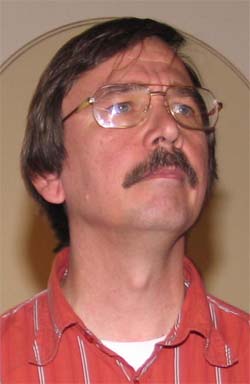
Dr. ing. Ger Koper
Delft University of Technology, Department of Chemical Technology (DCT-PCMT), The Netherlands
Title Lecture
UV-protective coatings: what to learn from nature
Authors
J.F. Jacobs, G.J.M. Koper and W.N.J. Ursem
Abstract
Biosystems use a variety of mechanisms to protect themselves against the harmful effects of UV-irradiation. These include pigmentation, radical scavenging, and damage repair mechanisms. We present the interesting example of the Pinus mugo subs mugo where a natural coating with very special properties is used. This natural coating formed by the cuticalar wax layer, has the interesting property that it not only contains chromophores that absorb the most harmful UV-components of the solar radiation reaching the leaves, but that in addition the absorbed energy is converted into useful light for the photosynthesis in lower-lying cells. We discuss some potential coating technologies where this same principle of turning useless, or even harmful, radiation into useful energy is used.
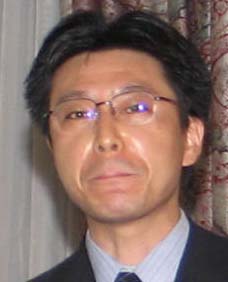
Dr. Yoshinori Kushi
Nippon Paint Co. Ltd, Corporate Research Laboratory, Osaka, Japan
Title Lecture
Molecular Design of Novel Grafting Polymer for Aqueous Pigment Dispersants
Authors
Yoshinori KUSHI
Abstract
Novel grafting copolymers containing
nonionic and/or ionic hydrophilic branches have been synthesized and
tested as dispersants of various organic and inorganic pigments for
waterborne pigment concentrates.
The influence of the types and quantities
of functional groups providing water-soluble and anchoring properties
onto dispersant upon the particle size and viscosity of pigment
dispersions was studied using dynamic light scattering (DLS) and
viscometer. In particular, introduction of hydrophobic moieties, like
aromatic rings as the anchoring groups, resulted in making highly
stabilized dispersions for a long period of time.
Moreover, to facilitate the selection of
suitable hydrophilic branches for a superior aqueous dispersant, the
interaction between the hydrophilic moieties of dispersants and ambient
water molecules was examined.
In this presentation, an appropriate structure for aqueous pigment dispersants will be proposed.
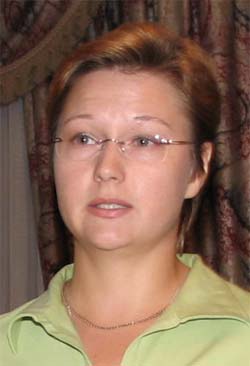
Dr. Sviatlana Lamaka
Department of Ceramics and Glass Engineering, University of Aveiro, Aveiro, Portugal
Title Lecture
TiOx nanostructured sublayer as reservoir of corrosion inhibitors for pre-treatments with self-healing ability
Authors
Sviatlana V. Lamakaa, Mikhail L. Zheludkevicha, Kiril A. Yasakaua, M. Fatima Montemorb, Patricia Cecílio , Mário G.S. Ferreiraa
Abstract
The development of new coating systems with active corrosion protection
instead of the carcinogenic chromates is an issue of prime importance
for the wide range of industrial applications.
In this work we propose a novel approach that aims at developing a
nanostructured porous reservoir that supports the corrosion inhibitor on
the metal/hybrid sol-gel film interface.
The nanostructured porous TiOx layer was obtained on the 2024 aluminium
alloy surface by controllable hydrolysis of the titanium alkoxide in
presence of a templating agent leading to formation of TiOx
self-assembled networks, replicating the structure of the etched alloy.
Titanium oxide films loaded with organic inhibitors and coated with a
sol-gel based thin hybrid film were used as effective
environmental-friendly corrosion protective pre-treatments for metallic
substrates. In contrast to direct embedding of the inhibitors in sol-gel
matrix, the use of the porous reservoir eliminates the negative effect
of the inhibitor on the stability of the hybrid sol-gel matrix.
TiOx – inhibitor – sol-gel systems show enhanced long-term corrosion
protection and well-defined self-healing effects confirmed by EIS and
SVET (Scanning Vibrating Electrode Technique) measurements. The
morphology and the structure of the TiOx film were characterized with
SEM, EDS, TEM and AFM techniques.
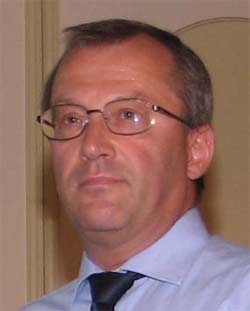
Dr. Daniel Maetens
Cytec Surface Specialties, Anderlechtstraat 33, B-1620 Drogenbos, Belgium
Title Lecture
Weathering degradation mechanism in polyester powder coatings
Authors
Dr Daniel Maetens
Abstract
The replacement of terephthalic acid (TPA) by isophthalic acid (IPA), an
isomer of TPA, in the polyester backbone produces a huge increase in the
weathering resistance of powder coatings exposed to tropical climate.
Super durable powders containing IPA-based polyesters achieve more than
10 years of exposure in Florida a significant improvement over the 2 to
4 years recorded with coatings containing TPA-based polyesters.
The study of weathering of IPA- and TPA-based powder coatings in
accelerated weathering chamber has shown with support of FTIR
spectroscopy, the formation of photo-byproducts that are proposed to be
generated by a photo-induced oxidation converting -CH2- in β position to
CO of esters into anhydride groups. Subsequent hydrolysis of these
anhydrides is responsible of polymeric chain cleavage generating acidic
groups and coating bleaching which in turn appear as poor weatherability.
FTIR analysis of exposed panels in Florida has demonstrated presence of
same photo-byproducts but a contribution of hydrolysis of ester groups
and/or oxidation of -CH- sites have to be integrated in this mechanism.
Biography
Daniel Maetens got his PhD in Organic Synthesis in 1980 from the University of Brussels, ULB. He started his career at the Central Research Lab of Solvay – Belgium located in Neder – Over – Hembeek, near Brussels. He worked on the structure identification of PVDF by using NMR techniques. In 1983, he joined UCB Chemicals in the R&D facility on the site of Drogenbos, also near Brussels. After 5 years working in the Powder Coating Resins Department as chemist, he became Group Leader Powder Coating Resins, a position that he is currently filling in the R&D Department of the newly created Cytec Specialty Chemicals (Drogenbos site).
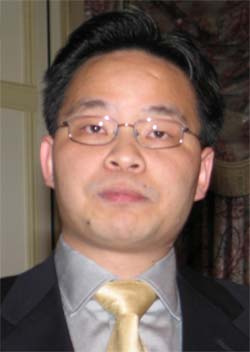
Marshall Ming
Eindhoven University of Technology, The Netherlands
Title lecture
Surface wettability control inspired by Nature
Authors
W. Ming,* D. Wu, R. van Benthem, G. de With
Abstract
Millions of years of evolution in Mother Nature have perfected the design of the films of desired surface wettability. For instance, the leaves of the sacred lotus flower, known as “rising out of muddy water, untainted”, demonstrate self-cleaning property, which is due to a combination of low surface-energy species and a peculiar topographic feature based on dual-size roughness: the coarse-scale rough structure is about 10-20 µm whereas the finer structure on top of the coarse structure is in the range of a few hundred nanometers. Inspired by the lotus leaf structure, we prepared superhydrophobic epoxy-based, PDMS-surface-modified films from raspberry-like silica particles, on which the advancing contact angle for water is about 165° and the roll-off angle of a 10-µL water droplet is < 3°. The surface wettability (superhydrophobic vs superhydrophilic) can be tuned by introducing a thermally responsive polymer layer. It is envisaged that the robustness and simplicity of this procedure may enable widespread applications of so-prepared films.
Biography
W.(Marshall) Ming is an Assistant Professor (UD) in Polymer Chemistry & Coatings Technology since November 2000. He received his B.S. in Materials Chemistry at Fudan University in Shanghai in 1993, and a Ph.D. in Polymer Chemistry and Physics in 1998 from the same university with Prof. S. Fu, Prof. F. N. Jones, and Prof. T. Yu as supervisors. From January 1996 to June 1997 he was a research associate with Prof. F. N. Jones in Coatings Research Institute at Eastern Michigan University. From November 1998 to October 2000 he was a post-doc fellow at Prof. van der Linde's group of Coatings Technology. His current research interests include nature-inspired functional polymers, nanostructured materials and applications, and environmentally benign polymer systems.
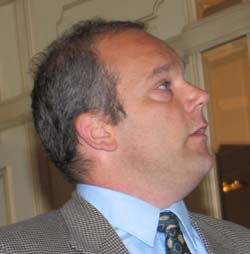
Tijs Nabuurs
DSM NeoResins, The Netherlands
Title Lecture
Nanomorphology control in aqueous coatings
Authors
T. Nabuurs, S. van der Slot, F. Bückmann, A. Overbeek
Abstract
In the last decade the
performance of poly(meth)acrylic dispersions as binders for aqueous
coatings has improved dramatically by optimisation of particle
morphology. By having two or more polymer phases present in one
particle, average domain sizes can be decreased and compatibility
between the polymer phases increased over simple blends yielding higher
performance final coatings.
In this paper we will
demonstrate that morphology control can be taken right down to the
individual polymer chain level to achieve so called nanomorphology
control.
Nanomorphology control
is achieved by copolymerising functional macromonomers in emulsion
polymerisation. In this way comb like polymer chains are prepared. By
varying composition of the various phases and molecular weights of the
macromonomers coating properties can be optimised. The benefits of
nanomorphology control in the final coatings will be described
Biography
Tijs Nabuurs graduated in 1991 from the University of Nijmegen in the
group of prof. Nolte. He obtained his PhD in 1997 from the University of
Eindhoven in the group of prof. German. His PhD thesis was on
alkyd-acrylic hybrids prepared by emulsion polymerisation.
In the same year he started to work for Zeneca Resins, in the acrylic
emulsions team.
His main interests over the years have been particle morphology control
of aqueous polymer emulsions, crosslinking in coatings and controlled
radical polymerisation.

Louise Nobel
Delft University of Technology, Department of Chemical Engineering, Section Nano Structured Materials, NSM, The Netherlands
Title Lecture
Waterborne nanocomposite coatings
Authors
M.L. Nobel, Prof.dr. S.J. Picken, Dr. E. Mendes
Abstract
Organic acrylic polymers in aqueous dispersed form are binders that can be used for the production of environmentally friendly coatings. The film properties have been improved by adding small amounts of fully dispersed inorganic hard phases in the form of needle shaped Boehmite, disc shaped Laponite and Montmorrilonite sheets. Depending on the location and structure of the nanoparticles in the emulsion after application and curing of the nanocomposite binder various morphologies are found in the transparent and flexible films. Hydrophilic nanoparticles located at the interfaces of the polymer droplets and hydrophobic nanoparticles completely or partially located inside the polymer droplets yield dramatically increased strength of the cured film as well as an adjustable rheology of the binder. Improved blocking and scratch resistance, higher elasticity and improved indentation hardness are thought to result from the high aspect ratio of the filler particles.
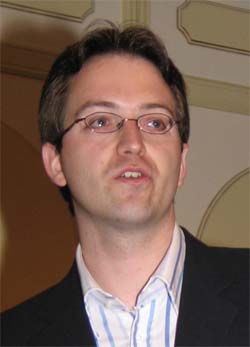
Bart Noordover
Laboratory of Polymer Chemistry - Eindhoven University of Technology, The Netherlands
Title Lecture
Renewable polyester resins for powder coating applications
Authors
B.A.J. Noordover, R. Duchateau, C.E. Koning, R.A.T.M. van Benthem, W. Ming, J. van Haveren, A.E. Frissen
Abstract
Monomers from renewable sources are
attractive starting materials for polymer synthesis, since building
blocks with great functional diversity are available from a wide range
of resources. Thermosetting coating systems often contain low molecular
weight polyesters as binder resins. Conventional coating resins contain
terephthalic moieties, obtained from fossil feedstock, to increase Tg.
In this study, we synthesized renewable
polyesters through polycondensation of diol and diacid monomers.
Aliphatic polyesters were synthesized using monomers such as succinic
acid, 2,3-butanediol, 1,3-propanediol and isosorbide. The latter, a
rigid bicyclic molecule with two hydroxyl functionalities, was
introduced to increase Tg. Glassy polyesters with Mn > 2000 g/mol and
T–g > 45 °C were obtained, having either hydroxyl or carboxylic acid
end-groups for curing purposes. The materials are thermally stable up to
250 °C. Reacting linear OH-functional resins with citric acid moieties
significantly increased polyester functionality.
The resins were cured using conventional
cross-linkers: poly-isocyanates for OH-functional materials and
triglycidyl isocyanurate or primid for COOH-functional resins. Using
branched polyesters instead of linear polymers significantly improved
coating performance. The resulting colorless to pale yellow coatings
show good resistance to solvent (> 100 acetone double rubs) and rapid
deformation (impact testing). In addition, they have König hardnesses
exceeding 200 seconds.
The work described here is financed by the
Dutch Polymer Institute.

Dr. Willem Posthumus
Stahl International BV, Waalwijk, The Netherlands
Title Lecture
Reactions of carbodiimides with free and bonded carboxylic acids
Authors
W. Posthumus, A.J. Derksen, L.C.J. Hesselmans
Abstract
The reactions of carbodiimides with carboxylic acids are well-described for liquid systems. If the carbodiimide-carboxylic acid reaction is used for crosslinking of polymers, the reactive groups have a limited mobility which may affect the course of the reactions. In this paper we discuss the reactions of polycarbodiimides with both free and bonded carboxylic acids. The reaction of carbodiimides with carboxylic acids can result in different groups like acyl-urea, dicarboxylic acid anhydride, amide, and isocyanate. When comparing the reactions of polycarbodiimides with carboxylic acid monomers and with polymers with attached carboxylic acid groups major differences can be found. Not only are the rate of the reactions and the maximum conversion affected, but also the type of the newly formed groups. The effects of polycarbodiimide concentration and functionality are described and the kinetics of the crosslinking of carbodiimides is compared with the kinetics of polyaziridine crosslinking.
Biography
Willem Posthumus was born on the 5th of December in Wijnjeterp, the Netherlands. He studied chemistry at the University of Groningen with a specialization in Organic Chemistry. After working for one year at Philips CFT he went to the Technical University of Eindhoven to obtain a PhD. With Professor van der Linde as promoter he successfully defended his thesis on UV-curable acrylate metal oxide nanocomposite coatings. Since 2004 he is working as chemist in the research and technology laboratory of Stahl International bv in Waalwijk, the Netherlands.
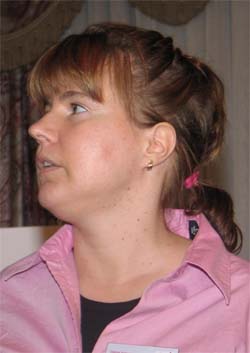
Dr. Paula Puomi
University of Cincinnati, Department of Chemical and Materials Engineering, Cincinnati, OH USA
Title Lecture
Novel, one-step, chromate-free coatings containing anticorrosion pigments for metals
Authors
W.J. van Ooij, P. Puomi, A. Ashirgade, S. Bafna, A.Seth, C. Shivane and Z. Yin
Abstract
The concept of superprimers, i.e., primers for metals with the conversion coating built in, has proven to be feasible. Such primers do not require a chromate (or other) conversion treatment of the metal and can be applied on any bare metal. The VOC content in the primer is kept low by using water-dispersed organic resins. Because of the high concentration of organofunctional silanes contained in the superprimer, its adhesion, both to the substrate and to overcoats, is excellent. The corrosion resistance of the primer can further be improved by adding corrosion inhibiting pigments such as micronized phosphate into the formulation. In this presentation we will discuss epoxy-silane, acrylate-epoxy and novolac-polyurethane based systems for aluminum alloys, HDG steel and CRS. The corrosion protection performance of these coatings is evaluated using electrochemical methods and performance tests. The reactions occurring in the superprimer dispersion have been analyzed by NMR and the resulting coatings with SEM/EDX, TOF-SIMS and FT-RAIR. The characterization methods have provided information on the formation of the coatings and the mechanism by which the coatings protect the metal substrates. It will also be shown that 2000 hours of salt spray resistance has been obtained with the primers both on AA2024-T3 and HDG steel.
Keywords: silane, superprimer, pigment, chromate, aluminum alloy
Biography
Paula Puomi is a post-doc fellow in Materials Science at the University of Cincinnati. She helds a D.Sc. in physical chemistry from Åbo Akademi University, Turku, Finland. She did her D.Sc. Thesis “Pretreatment of galvanized steel in relation to paint adhesion and corrosion resistance” in collaboration with Rautaruukki Steel to whom she also developed a chromate-free coil coating process in 2001. Her research interests are in corrosion, silane paint chemistry and surface characterization. She has authored and co-authored about 15 papers and worked as a teacher on all levels from university to upper secondary school.
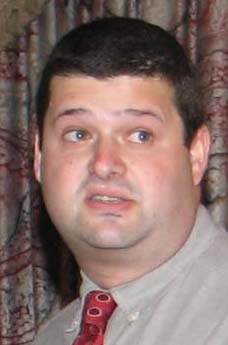
Alexander Routh
Department of Chemical and Process Engineering, University of Sheffield, Mappin Street, Sheffield S1 3JD UK
Title Lecture
Surfactant distributions in latex films
Authors
Venkat Gundabala and Alexander Routh
Abstract
Surfactants are added
to latex dispersions during particle synthesis to aid particle
stability. The location of this surfactant in the final film can have
dramatic effects on the film performance. For example, accumulation at
the substrate will affect adhesion, whilst accumulation at the air
interface affects feel and gloss.
A transport model for
surfactant distributions through the film reveals the surfactant
adsorption isotherm to control the distribution and Rutherford Back
Scattering has been used to examine the distribution for four different
surfactants. These experiments also reveal the large lateral
inhomogeneity in surfactant concentration
Marangoni flows, which
result from surface tension gradients cause thinning in liquid films.
Such flows are caused by surfactant concentration gradients and the
lateral flow, film thinning and even rupture of latex films has been
observed. In this work thin film fluid mechanics is linked with
profilometry experiments of the final latex film profile.
Biography
Education
- PhD, Princeton University, USA 2000
- BA, MA, MEng, Cambridge University, 1995
Employment
- January 2006 – present Lecturer, Department of Chemical Engineering, University of Cambridge
- January 2002 – December 2005 Lecturer (senior lecturer from Oct 2005), Dept of Chemical Engineering, Sheffield University
- December 1999 – December 2001 Post-Doctoral Research Associate, Bristol University
- September 1995 – December 1999 PhD (May, 2000), Dept of Chemical Engineering, Princeton University, USA
Research Interest
To understand macroscopic phenomena from the microscopic and nano-scale
architecture of materials: I have achieved world-leading expertise in
drying of dispersions and modeling of film formation. My future
research directions include morphological manipulation of encapsulating
particles resulting in external control of chemical reactions. In
addition I am currently moving into bio-related fields, including
protein separation and enzymatic reactions, in collaboration with
colleagues in Cambridge and elsewhere
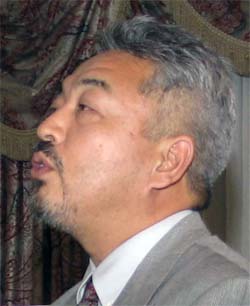
Dr. Hiroshi Sasaki
Taogosei Co. Ltd, Nagoya, Japan
Title Lecture
High Performance Cationically Curable Formulations
Authors
Hiroshi Sasaki
Abstract
Photo-cationic formulations are known to possess high performance such
as good adhesion to substrates, low shrinkage cure and so on. At the
same time, their curing speeds, however, are rather slow. In the
cationic ring-opening polymerization of cyclic ethers, three major
factors, i.e. ring strain, basicity and steric factor, are known to
govern the reactivity. Using computational calculation method, we have
already investigated those factors and correlated to the actual physical
properties.
At present stage, oxetanes and cycloaliphatic epoxides seem to be the best
candidate for the high performance formulations.
In this presentation, the latest investigation of the curing mechanism of above
monomers together with performance of their formulations will be discussed.
Biography
Educational Background
- 1986 Master Degree at Hokkaido University
- 1996 Doctor Degree in Polymer Chemistry at Hokkaido University
Work Experience
- 1986-Present Researcher at Toagosei Co. Ltd.
- 1991-1992 Visiting scientist of Prof. Crivello's lab at Rensselaer Polytechnic Institute
Research Interests
- Design, Characterization and Evaluation of Photo- or Thermal-Curable Materials
- Cationic Ring Opening Polymerization of Cyclic Ethers
- Polymer Chemistry
- Computational Chemistry
- Rheology
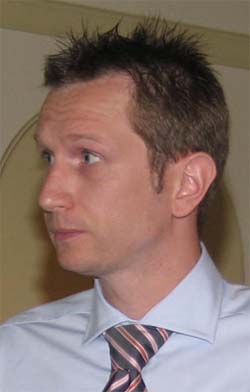
Carsten Schellenberg
Ciba Specialty Chemicals Inc., Coatings Effects Segment, Basel, Switserland
Title Lecture
Polymer colloids by miniemulsion polymerization - new additives for waterborne coatings -
Authors
Delphine Kimpel, Wolfgang Peter, Carsten Schellenberg
Abstract
The number of waterborne applications is increasing in different coating
areas. On the other hand many additives were developed for solvent-borne
coatings only. These substances (e.g. light stabilizers) are hydrophobic
in nature and can’t be used in waterborne systems directly.
Progress has been made with the development of waterborne product forms
of hydrophobic, water-insoluble additives by using heterophase
polymerization techniques. The interdisciplinary combination of colloid,
macromolecular and organic chemistry lead to the availability of
advanced additives for a broad range of waterborne paint formulations.
The wood photoprotection against discoloration and broad compatibility
can be significantly improved by using the new additive - waterborne
product form of a red-shifted UV-absorber based on triazine chemistry -
in either film forming or penetrating wood coatings for example.
Based on this nanoencapsulation technology further high performance
additives such as UV-absorbers or hindered amine light stabilizer (HALS)
hitherto limited to the solvent borne coatings market are in the
innovation pipeline for transformation into true stir-in additives for
the growing and environmentally friendly waterborne coatings market.
Biography
Carsten Schellenberg studied chemistry at University of Marburg (Germany), where he graduated in 1997. Afterwards he joined Max Planck Institute of Colloids and Interfaces and obtained PhD degree in the field of polymer colloids. In April 2000 he joined Ciba Specialty Chemicals in Basel working as R&D project leader in Coating Effects Segment on different projects for BL Coatings. His main focus was on additives for waterborne coatings. Since 2005 he is at the R&D Center in Amagasaki (Japan) working as project leader in the area of flat panel displays for BL Electronic Materials.
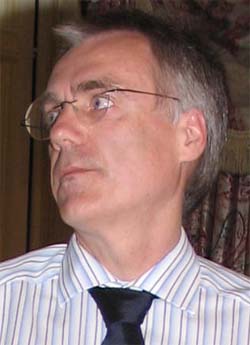
Wolfgang Schrof
BASF Aktiengesellschaft, Ludwigshafen, Germany
Title Lecture
Combinatorial Materials Research of UV Coating Formulations
Authors
W. Schrof, S. Koltzenburg, N. Gruber, R. Schwalm, W. Paulus, E. Beck, H. Larbig
Abstract
Isocyanateacrylate molecules with both acrylate and isocyanate functionalities can act as starting materials for versatile toolboxes of radiation curable binders. UV Formulations of these binder libraries with commercial reactive acrylate thinners of different functionalities and concentrations will yield attractive coating properties. Combinatorial methods are intensively used to prepare, coat, cure, and characterize the coating films for hardness, elasticity, scratch and chemical resistance. The results are discussed using network simulation and measurements of UV conversion by Raman spectroscopy.
Biography
Wolfgang Schrof was
educated in physics at the universities of Ulm and Stuttgart. After PhD
he joint BASF Aktiengesellschaft in 1987. There he worked in the polymer
physics department in the field of laser spectroscopy (nonlinear optics,
two-photon microscopy, Raman microscopy, and real-time IR spectroscopy).
Today he is head of
combinatorial materials research (CMR). This technology offers the
perspective to accelerate industrial research for superior polymers,
catalysts, formulations and coatings. He is taking care for the
developing and implementing combinatorial tools (parallel reactors,
formulation robots, automated application testing, data management and
mining), for combinatorial projects in collaboration with internal and
external customers and for the contacts to academia and start-ups active
in CMR.
He heads the
DECHEMA working group on high-throughput research.
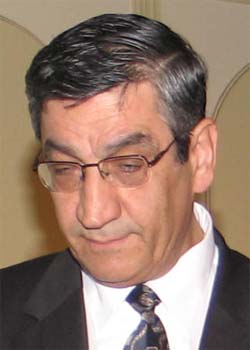
Mohamad Shalati
Nuplex Resins LLC, Louisville, USA
Title Lecture
Controlled molecular structure polymers
Authors
E. Bzowej, R. Brinkhuis, M. Gessner, and M. Shalati
Abstract
Increasingly stringent environmental regulations continue to challenge the automotive coatings industry to reduce emissions while improving film properties at the same time. Achieving performance requirements as the VOC is lowered can be met using Controlled Molecular Structure Polymers (CMSP). CMSP polymers are polyols that possess controlled distribution of functionality, structure, lower molecular weight and narrow polydispersity. 1K and 2K prototype coating formulas have been developed for OEM and Vehicle Refinish clear coats having VOCs in the range of 350 – 400 g/l, good scratch resistance, durability, and environmental etch resistance equal to or better than commercial clear coats. This presentation will focus on structure-property relationships for polymers and coatings.
Biography
Mohamad Shalati received his:
- B.Sc. Chemistry – Damascus University – 1971
- M. Sc. Chemistry – Eastern Michigan University – 1974
- Ph.D. from the University of Michigan in 1979: Chemistry and Macromolecular Science & Engineering under the direction of Prof. Charles G. Overberger.
25 Years of Industrial Experience in Polymers and Coatings at:
- Procter & Gamble
- Sherwin Williams
- PPG Industries
- Akzo Nobel Resins
- Nuplex Resins
He is the author / inventor of over 50 Patents and Publications in Polymer Synthesis, New Chemistry, and Coatings
He assumed various Technical and Managerial responsibilities in R&D capacities .
He is currently the Director of R&D at Nuplex Resins for the Americas, and residing at the Louisville, Kentucky Lab.
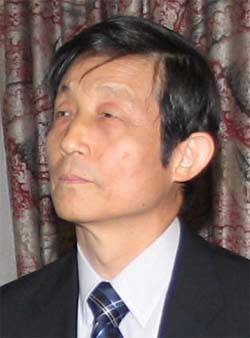
Prof. Masamitsu Shirai
Osaka Prefecture University, Department of Applied Chemistry, Osaka, Japan
Title Lecture
Reworkable UV curing materials
Authors
M. Shirai
Abstract
UV curing materials are widely used as coating materials, printing inks, adhesives, photoresist, and solder masks, because the cured materials show excellent physical and/or thermal properties. In some cases, we need to remove the cured materials to repair or reuse the substrates. However, it is difficult to thoroughly remove the crosslinked materials from the substrate without damaging underlying materials. In this paper, we report the UV curing materials which become soluble in solvents by thermal degradation. We have newly synthesized multifunctional monomers which have epoxy, acrylate, or methacrylate units as a crosslinkable moiety. Those monomers also have thermally degradable units such as tertiary ester linkages, acetal linkages or hemiacetal ester linkages in a molecule. Photo- and thermal curing of those monomers and thermal degradation of the cured materials are studied in detail. The onset temperature of degradation was strongly dependent on the structure of the monomers.
Biography
Masamitsu Shirai
received his Ph.D. degree from Osaka Prefecture University (OPU) in
1978. After working as an assistant professor and then an associate
professor at OPU, he was promoted to a professor of applied chemistry at
OPU in 1997. He spent his early career as a postdoctoral fellow
(1978-1979) at State University of New York at Syracuse, USA.
His research interests include synthesis and applications of photosensitive
polymeric materials, especially photoresists, photoacid generators,
photobase generators, UV curing materials, and photodegradation and
stabilization mechanisms of polymeric materials. He has published more
than 250 research papers including reviews and books.
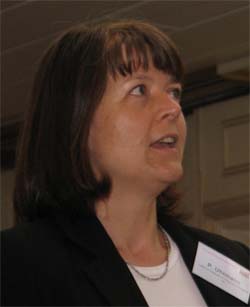
Dr. Petra Uhlmann
Leibniz Institute of Polymer Research Dresden, Dresden, Germany
Title Lecture
Research agenda surface technology: Future demand of research in the field of coatings materials
Authors
Petra Uhlmann, Ralf Frenzel and Brigitte Voit
Abstract
The acquisition of the future demand of research in the field of
innovative coatings materials was one part of a project funded by the
German Ministry of Education and Research and coordinated by the German
Research Society of Surface Treatment (DFO, Düsseldorf) with the aim to
identify the demand of research in the area of surface technology in the
next 10 to 15 years [1]. In the project development several German
research institutions and numerous representatives of companies acting
in the field were involved.
The functions of coated materials that were identified to be the most
innovative and to have the biggest driving force for research will be
shown for certain industrial branches. The most promising coatings
materials to fulfill the desired functions in the future will be
discussed, visions will be mentioned and conclusions about general
trends in the field of coating materials will be drawn.
Biography
Background:
- Graduated from Dresden University of Technology in Chemistry in 1992,
- PhD at Dresden University of Technology about waterborne coatings as primers for corrosion protection, 1992-1993,
- Post-doctoral stay at CNRS, Centre de Recherches sur la Physico-Chimie des Surfaces Solides, Mulhouse, France, group Dr. E. Papirer
Career:
Since 1993 at the Leibniz Institute of Polymer Research, Dresden,
current position: group leader in the department of Nanostructured
Materials (head: Prof. Manfred Stamm), field of work: functional,
nanostructured and switchable polymer thin films and coatings.
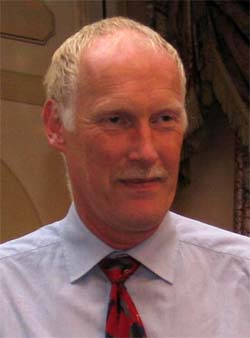
Leo van der Ven
Akzo Nobel Coatings Research Arnhem, P.O. Box 9300, 6800 SB Arnhem, The Netherlands
Title Lecture
Interactions between basecoats and clearcoats in Car Refinish systems
Authors
Leo G.J. van der Ven, René T.M. Leijzer,Nico van Duijvenvoorde, Keimpe J. van den Berg
Abstract
The introduction of
VOC compliant waterborne basecoats and solventborne basecoats on one
hand and the introduction of VOC compliant clearcoats on the other hand
forces to look to the interactions between the two systems. As well known from
studies in the automotive OEM area small molecules like HALS and
UV-absorbers additives diffuse from the clearcoat into the basecoat.
This influences the durability performance of the system. The main question
addressed in this paper is the interaction of the binder system of the
basecoat and clearcoat. In general crosslinkers for e.g. poly-urethane
coatings are rather low molecular weight materials which may diffuse
between layers as well. Also the lower molecular weight functional
resins of the binder may move throughout the system.
The interactions of
several basecoat/clearcoat combinations were investigated by means of
chemical and physical techniques. The effect of a medium solid clearcoat,
a VOC compliant p-urethane clearcoat and UV-clearcoat on
interpenetration, adhesion, physical and paint properties were studied.
Also some attention is paid to the
diffusion of HALS and UV-absorbers from the clearcoat into the basecoat.
Biography
Leo van der Ven received his degree in
chemical engineering in 1974. After his study he joint Akzo Nobel
Central Research as a gas chomatographic specialist.
In the beginning of the eighties he
shifted to the coating research group. First as research fellow dealing
several projects as durability of coatings, PUR curing and mechanistic
studies of isocyanate free systems.
Later on he focussed on the study of
waterborne systems, film formation, cure mechanisms and durability
prediction.
Currently he is responsible for the
coatings resin and film characterization group of Akzo Nobel Coatings
Research in Arnhem (the Netherlands).

Douglas Wicks
School of Polymers and High Performance Materials, The University of Southern Mississippi 118 College Drive #10076, Hattiesburg, MS 39406, USA
Title Lecture
Impact of Waterborne Dispersants on Biocide Efficacy
Authors
Douglas A. Wicks and Alicyn M. Rhoades
Abstract
The issue of polymer microbial degradation is of vital importance to researchers, producers, and the end market consumer. Waterbased polymeric formulations contain a myriad of components, consistently including dispersing groups and molecules. These may be ionic or non-ionic in nature, and fall into a wide range of chemical compositions. Biocide or preservative additives are also common components in the final formulation. Biocide molecules are added to effectively prevent and reduce microbial contamination within a formulation. These are traditionally tested under neutral conditions, but are expected to perform over time within the dynamic wet coatings environment with a wide range of chemical species and components not found in the base line studies. Work within our research group has shown the reality of interactions between surfactant and biocide molecules in solution, and that the chemical nature of the surfactant determines the resulting efficacy of the biocide molecules. The current study moves the research forward by looking at the effects of polymer bound dispersing groups and what the differences are between unbound versus bound functional groups.
Biography
Dr. Douglas A. Wicks is the Robert M. Hearin Support Foundation Professor of Polymer Science
in the School of Polymers and High Performance Materials at the
University of Southern Mississippi in Hattiesburg, MS. His current
research interests focus on development of new resins for coatings
applications, use of high throughput screening for studying formulations
and the investigation of polymers in biomedical applications. At USM,
Dr. Wicks heads a National Science Foundation (NSF) Partnership for
Innovation project on the use of High Throughput methods for the
investigation of polymeric formulations and NSF Integrative Graduate
Education Research and Training
(IGERT) program on Entrepreneurship at the Interface of Medicinal and
Polymer Sciences.
Prior to joining the
University of Southern Mississippi in 2002, he was at Bayer Corporation
for 13 years in a succession of research positions of increasing
responsibility. His final position at Bayer Corp. was as Vice President
for Research of the Coatings and Colorants Division with broad
responsibilities in all aspects of polyurethane and coatingcoating
technology. Dr. Wicks has 37 patents and 28 publications related to
polyurethane technologies for coatings, adhesives and sealants.
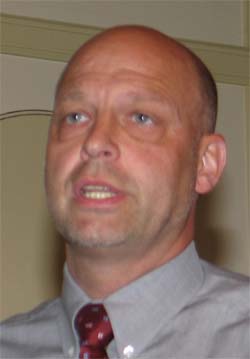
Dr. Harm Wiese
BASF AG, Ludwigshafen, Germany
Title Lecture
Nanocomposite dispersions - An innovation in waterbased coatings
Authors
Harm Wiese, Joerg Leuninger, Franca Tiarks
Abstract
We describe the preparation of new silica/acrylate nanocomposite particles by emulsion polymerization. Film formation of these nanocomposite dispersions takes place at the same temperatures as for acrylate dispersions having the same polymer composition, whereas film hardness and strength are strongly improved. The films are highly transparent, provide an excellent hardness/elasticity compromise, do not swell in water and show very low water whitening. Further film properties are high heat resistance, water vapour permeability, solvent resistance, adhesion to mineral substrates and a favorable burning behavior. Silica/acrylate nanocomposite dispersions therefore are a highly promising approach for solvent-free coatings. Special application features for paints are low dirt pick-up and high blocking resistance.
Biography
Dr. Harm Wiese, BASF AG Ludwigshafen born 1958, studied
Chemistry at the TU Darmstadt and got a PhD in Physical Chemistry in
1987 with an electrochemical study in the group of Prof. Konrad G. Weil.
After spending a postdoctoral year at IBM Rueschlikon/Switzerland with
Prof. Heinrich Rohrer he joined the Polymer Physics Department of BASF
AG's Polymer Research Division in 1989. In the following five years he
worked on the physicochemical characterization of highly concentrated
colloidal dispersions. In 1994 he moved to Emulsion Polymers Research
where he worked on the analytics of polymer dispersions, protective
colloids and nanocomposite dispersions as well as on applications like
adhesives and concrete roof tile coatings.
Since January 2004 he
is managing BASF's research group 'Coatings and Construction Chemicals'.

Frederik de Wit
Delft University of Technology, Department of Mechanical Engineering, Marine Technology and Materials Science and Engineering, Netherlands Institute for Metals Research (NIMR), The Netherlands
Title Lecture
Bonding of organic molecules on aluminium and magnesium alloy
Authors
F.M. de Wit, J.J. Kleikers, J. van den Brand, H. Terryn, J.H.W. de Wit
Abstract
To protect products based on aluminium alloys from corrosion in aggressive
environments, organic coatings are applied in industry. These coatings
sometimes do not adhere well in aqueous environments, resulting in
delamination. This lack of adhesion is not well understood. Van den
Brand [1,2] studied the bonding of specifically selected molecules
(representing polymers) to a relatively pure aluminium alloy, AA1050, by
FTIR-RAS. His results showed that the bonding of these molecules to
aluminium hydroxides could be influenced by changing the environment in
which they were applied or afterwards exposed to (e.g. air, N2 and
water).
In industry, aluminium alloys with a higher amount of alloying elements are
used because of their improved mechanical properties. The aim of this
research is to understand the bonding on the pure alloying metals, i.e.
pure aluminium (99,99%) and pure magnesium (99,99%) and industrial
alloys of the two. The number of hydroxide groups at the interface
depends on the pretreatment. For the Al/Mg alloys the surface layer can
be Mg rich, which will probably influence the bonding strength
considerably. The first results, which include the study of composition
and morphology of the surfaces by AFM, SEM, XPS and FE-Auger and FTIR
spectra showing details of the molecular bonds, will be presented.
- J. van den Brand, O. Blajiev, P.C.J. Beentjes, H.Terryn, J.H.W. de Wit, Langmuir 20 (15): 6308-6317 (2004)
- J. van den Brand, O. Blajiev, P.C.J. Beentjes, H.Terryn, J.H.W. de Wit, Langmuir 20 (15): 6318-6326 (2004)
- J. Flores, PhD Thesis, TU Delft, 2006, to be published
Biography
Frederik de Wit studied Materials Science and Engineering at Delft University of Technology. After receiving his master’s degree from the Corrosion Technology and Electrochemistry group, he started working on a PhD project at the Netherlands Institute for Metals Research in November 2004.
